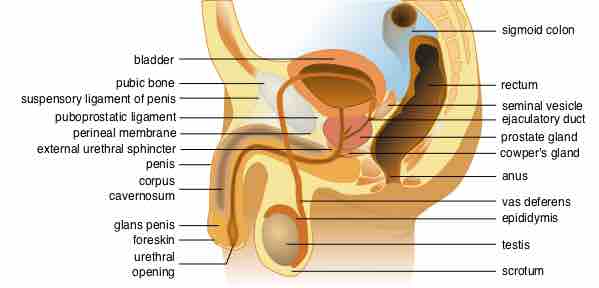The organs of the male reproductive system are specialized for three primary functions:
- To produce, maintain, transport, and nourish sperm (the male reproductive cells), and protective fluid (semen).
- To discharge sperm within the female reproductive tract.
- To produce and secrete male sex hormones.
External Male Sex Organs
Most of the male reproductive system is located outside of the man's body . These external structures are the penis, scrotum, epididymis, and testes.

Male Reproductive System
Lateral view of male reproductive system with organs labeled.
The penis is the male organ for sexual intercourse and urination. Semen and urine leave the penis through the urethra. The scrotum is a loose, pouch-like sack of skin that hangs behind the penis, containing the testes.
The scrotum has a protective function, including the maintenance of optimal temperatures for sperm survival and function. For sperm development, the testes must maintain a temperature slightly cooler than normal body temperature. Special muscles in the wall of the scrotum contract and relax in order to move the testes near the body.
The epididymus is located at the back of the testis and connects it to the vas deferens. Its function is to store and carry sperm. The testis is the location for testosterone production. The coiled collection of tubes within the testes are the seminiferous tubules. Within these tubules, spermatogenesis takes place.
Accessory Sex Organs
The internal organs of the male reproductive system are called accessory organs. They include the vas deferens, seminal vesicles, prostate gland, and bulbourethral (Cowper's) glands.
Vas deferens: Transports mature sperm to the urethra in preparation for ejaculation.
Seminal vesicles: Sac-like pouches that attach to the vas deferens near the base of the bladder. The vesicles produce molecules such as fructose that serve as energy sources for sperm. The seminal vesicle fluid makes up most of the volume of a man's ejaculate.
Prostate gland: A walnut-sized structure located below the urinary bladder in front of the rectum. It contributes additional fluid to the ejaculate that serves as nourishment for sperm.
Bulbourethral (Cowper's) glands: Pea-sized structures located on the sides of the urethra just below the prostate gland. These glands produce a clear, slippery fluid that empties directly into the urethra. Fluid produced by these glands lubricates the urethra and neutralizes acidity associated with residual urine.